The traditional knowledge of what colors, shapes, or designs of different South Sudanese traditional attires or beads symbolize is rapidly disappearing. Partly, this is due to the passing of elders, urbanization, migration, insecurity, and lack of respect for traditional knowledge as a knowledge system in the current education system, amongst other factors.
One of South Sudan’s core unifying dynamism is the culture and conventional attire. The attires represent the culture or identity of ethnic groups, gender, age, or marital status. Spoken languages and fashion frequently and prominently reflect cultural and social representations. These traditional attires include a variety of garments, jewelry, and beaded accessories that have historical roots and are essential to South Sudanese identities.
#ThisIsUs is a visual and written digital curation that highlights some South Sudanese cultural wears. After eleven years of independence from Sudan and ten years of internal instability, the curation aims to initiate knowledge sharing and provide insights and understanding of what different attires symbolize for diverse communities. Additionally, the curation seeks to create conversations on how cultural dressings influence perception in the past and present. Beaded accessories, for instance, are purposefully color-coded to indicate one’s age group or status, cultural beliefs, and expressions. Presently, beaded accessories are worn as a fashion statement, especially by the youth. Despite not always conveying the intended historical values, they serve as a representation of diversity and beauty. This series will provide an understanding of roots that shape our identities and respect traditional positive values while allowing the worldwide transition to a new society by connecting the past, present, and future.
For this round of curation, the series featured 16 photographs of various traditional attires to remind us that there is beauty and strength in diversity.
Ayor Dhuor, Achol Gai, Gloria Lifu, Sandra Adhieu, Lilly Joan, Asano, Jacky Aparo, Agau Bul, Katkuta Margaret, Aluel Gai, Hellen Hivita, Manuela Modong, Susan Samson, Mama Ropani, Mama Achol, Mama Owe
Mahandis Magic
Aluel Manyang
Hellen Hivita

Mundari girls and Women wear Tondura and Lawu. However, this attire is worn by other ethnic groups like the Dinka, famously known as attire for the Mundari women and girls.
Mundari girls and Women wear Tondura and Lawu. However, this attire is worn by other ethnic groups like the Dinka, famously known as attire for the Mundari women and girls. The lawu (the long cloth tied around) is a ‘modern’ addition. Traditionally, girls wore Tondura (the skirt) and another similar fabric for women with beaded corsets or tiny vests on top.
For women, especially married women, two goats of a different color would be slaughtered; the skin is used to make the cloth, so the back and front look different. ‘Meje,’ a substance like a red or dark brown dye, is used to finish the fabric and smear women's bodies to look beautiful. In the absence of 'meje,’ women wear 'palala,’ a dark brown lawu, as a substitute.
There is also much focus on the beads worn with this cloth or the Tondura by girls, and colors symbolize different things. Girls’ beads are made smaller and worn on the waist. The bead colors worn by girls are green (Agot), Red (Biny), and Guragany (combination of black and yellow), all sometimes mixed with white (Awak).
Married women wear a unique bead called ‘Nyelie’ around the waist. A newlywed woman wears a bead called ‘Baw’ around the leg, which makes some sound to let people know that she's a bride. A newly married girl/woman also surrenders her older beads to the new sisters-in-law and is given 'gung' on the wrist, 'smotic' referring to beads for the newly married woman 'bride.’ If it's plural, they called it 'aliab.
Sources: Khamisa Igai with interpretation support from Bush Buse
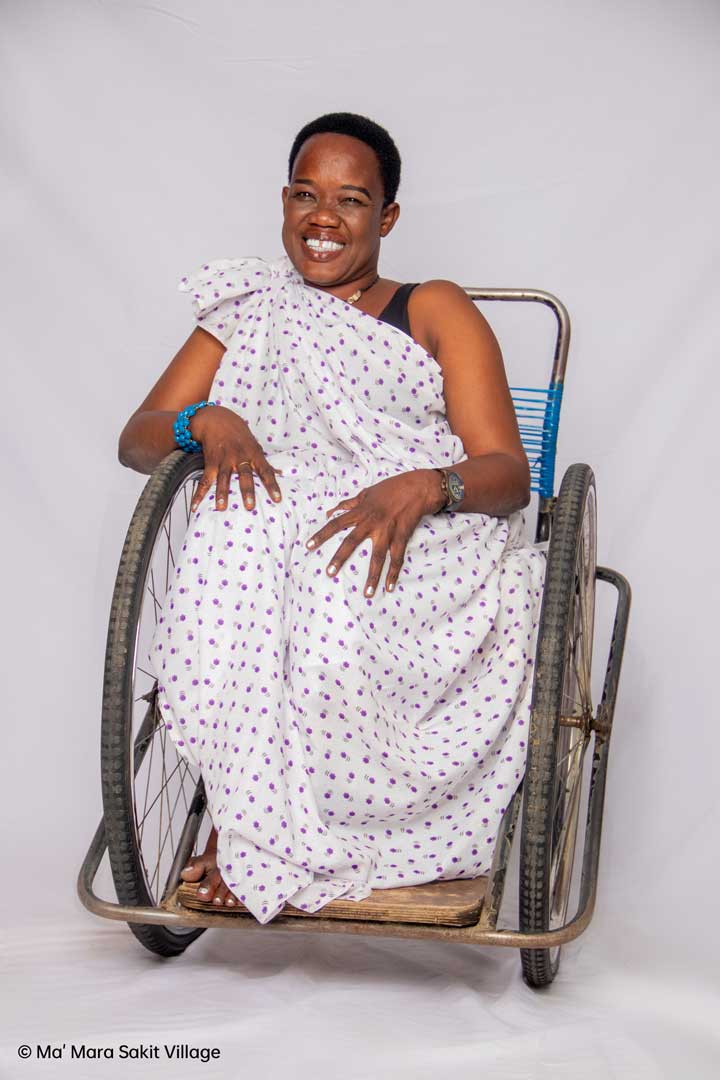
One of the most well-known and prominent Bari attires is the Lowa, or "Perida" in Rutan Bari (Bari Language). Women of all ages wear it, especially during important occasions. The Lowa is made of cotton and sometimes hints of silk in various colors.
One of the most well-known and prominent Bari attires is the Lowa, or "Perida" in Rutan Bari (Bari Language). Women of all ages wear it, especially during important occasions. The Lowa is made of cotton and sometimes hints of silk in various colors.
“Tondora” is the most famous traditional attire for girls and women. The Tondora is a skirt with a bra covering the chest area that can be worn at home, during celebrations, or at any given moment. It represents the Bari culture.
(Note: A bra is not required for a child wearing Tondora).
Another standard outfit is the "Bongo Na-Bari," which is made of a material tied to cover the front and back while remaining empty on the sides and having beads adorning the front.
When wearing the Perida or Tondora, it is usually a must to wear the Bari beads. Otherwise, the representation of the attire isn’t complete. A girl would often wear a minimum of 12 pieces of beads around the waist, known as “Luliat,” with a large one-piece referred to as “Gwolungti” and a neckpiece “Tiliakur” with small, round, and shiny earrings. The attire is completed by wearing sandals, “Sifinja,” or a pair once known as Mutukele back in the day.
Sources: Stella Kitale Swaka with support from Natalina Dariuous Ladu
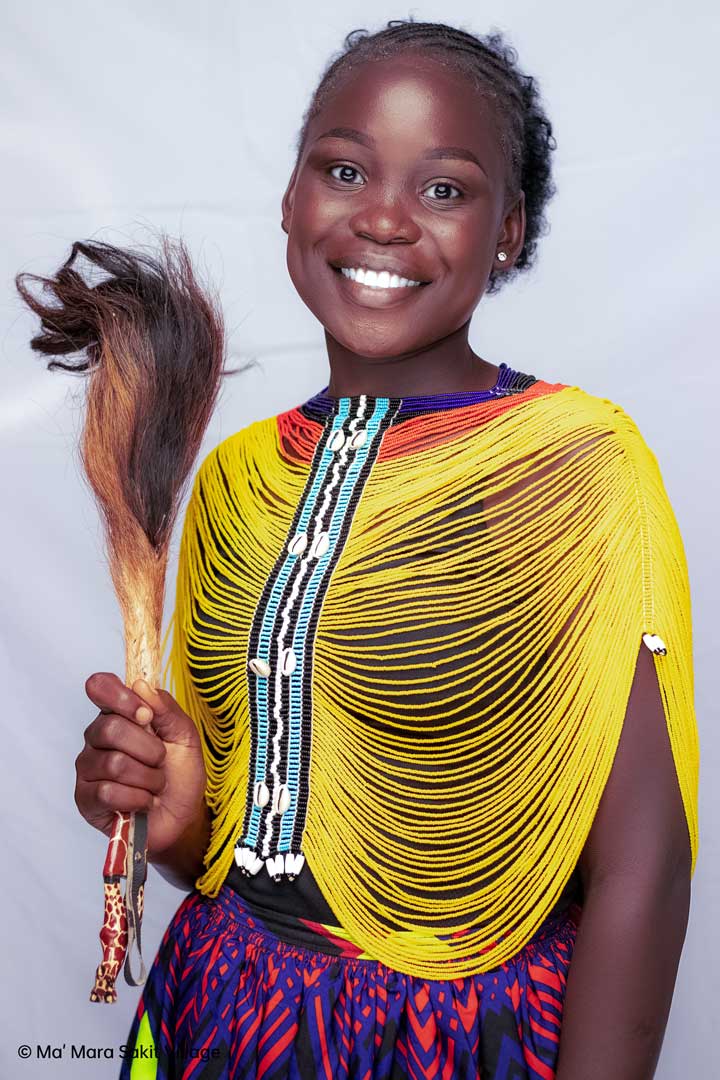
This is the beaded corset mostly worn by Dinka Bor, Dinka Yirol, and the Mundari people of South Sudan. The corsets have different names based on the colors of the beads and how the colors are arranged/alternated.
Today we are featuring the beaded corset mostly worn by Dinka Bor, Dinka Yirol, and the Mundari people of South Sudan. The corsets have different names based on the colors of the beads and how the colors are arranged/alternated. Culturally, different age groups wear certain color combinations. However, currently, this is not being closely observed as this young generation is open to exploring different colors of beads based on preferences rather than an alternation that implies the age group of the wearer.
For teenage girls, the beads are arranged in alternate and even rows of yellow (Këc), sky blue (Alak), blue, red, and black (Chöl), with Këc (yellow) being the dominant color hence the name.
Alual (Red) or Bïny: Depending on the beads’ shade, it is worn by older girls of 20 years and above. Red is the dominant color hence the name "Alual," which means red, and "Malual" for men's corsets. Red is alternated with black and white beads or black, white, blue, and sky-blue beads at the corset's top, bottom, and middle.
Chöl (in Dinka) and Ayoran (in Mundari): Are worn by much older and unmarried young women. Here black beads are the dominant color mixed with white on the edges. When a young woman is believed to have surpassed the 'expected age of marriage,' she starts to wear this color. It is, however, uncommon because women across these three ethnic groups are married off early.
Gor: This is a body-hugging type of beaded corset. Unlike this beaded corset that is loose and free, Gor is meant to be tied to the body. It’s worn by both girls/boys and men/women, and color combinations mean the same thing.
Sources: Aluel Kuojok Athac, Amer Manyang Dot, Khamisa Igai, Aluel Gai

Lawa is one of the most famous South Sudanese cultural outfits and is mainly associated with the Shilluk (Collo) people. For the Collo, each village wears a different color of lawa, and beads are usually based on animals or birds such as (buffalo, rhino, tiger, swallow, etc.).
Lawa is one of the most famous South Sudanese cultural outfits and is mainly associated with the Shilluk (Collo) people. For the Collo, each village wears a different color of lawa, and beads are usually based on animals or birds such as (buffalo, rhino, tiger, swallow, etc.). The colors are further subdivided based on age and gender. For example, girls and women wear different colors.
Unlike in this photo shoot, the color of the lawa and ‘nyileu’ (a combination of beads worn on the neck, head, and arm/wrist) are often matched; however, the bead tied on the waist is only worn by married women. The bead worn on the neck has been modified over time, and different designs have been made, like the one worn in this picture.
The most common one is slightly bigger and designed with a long tail-like extension at the back and colors coordinated with the lawa based on clan colors and age group. (Reference: last image attached)
However, one bead is often worn by all Shilluk people, the green and white beads. The green represents Nyikayo, the mother of Nyikang, the god of the Collo, and the white signifies peace. This is the one that unites all the chollo, so everyone from the kingdom wears it.
Sources: Abuk Payiti, Mary Nyawunya, Sabrine Nyangin

Aweil cultural attires are majorly inclusive and hold little difference between women’s and men’s wear. The cultural attires are worn to attend the Ayakdit (a cultural dance).
Aweil cultural attires are majorly inclusive and hold little difference between women’s and men’s wear. The cultural attires are worn to attend the Ayakdit (a cultural dance). The Aweil cultural attires are a symbol of unity of the people.
Both men and women wear Jama(wrapper). However, women wear waist beads known as “Abireth” to set them apart from their male counterparts. “Maweer” beads are worn on top of the vest, and Gaar (Bau) is worn around the ankles while Dhuor (feather-like a stick) is held by the hand (refer to image).
Recently socks matching Jama’s color have been adopted. The socks are worn for beautification but mainly to protect the ankles from the Gaar-Bau while dancing.
Sources: Ayakdit Cultural Group with support from Tong Deng
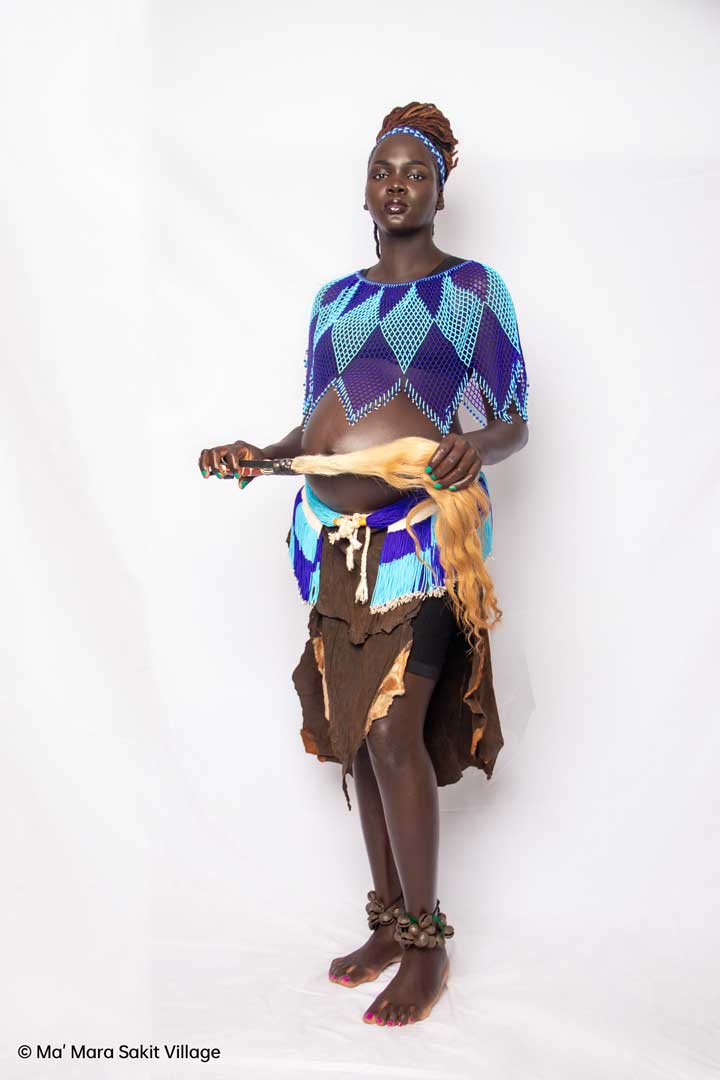
This is an attire worn by married women and mostly during happy or moments of celebratory dances.
This is an attire worn by married women and mostly during happy or moments of celebratory dances. For example, “Echaha”; is a dance praising and dancing for the king, and the “Ekanga” is a dance celebrating the harvest. Another popular dance this attire is worn during is the “Efira,” a handover celebration done after every 22 years. A handover of leadership from the previous generation to the next. The last handover done was Sept. 2021.
This attire comes in different colors. In the past, it would be colorful, but nowadays, people prefer a mixture of two colors. The most popular ones are blue and white, and yellow and blue.
The round beads at the bottom are referred to as “Eloboni,” while the “Egama – Waja Waja” beads are on top. Some women prefer to wear Egama with “Ataga,” though men mostly wear it. “Enafi” is the leather underneath the bottom beads, while the “Etorhou” is on the head.
Sources: Hellen Hivita with support from Mama Celena

This is a Lotuko attire popularly worn by unmarried women and young girls. The top beads are known as Egama, while the waist beads are known as Emunya.
This is a Lotuko attire popularly worn by unmarried women and young girls. The top beads are known as Egama, while the waist beads are known as Emunya. Underneath the waist beads is a skirt known as Tondora.
Back in the day, the Lotuko did not wear skirts; they wore the “Emutuk,”; a piece instead of the Tondora. “Etorhou” are the beads put on the head.
Source: Hellen Hivita with support from Mama Celena
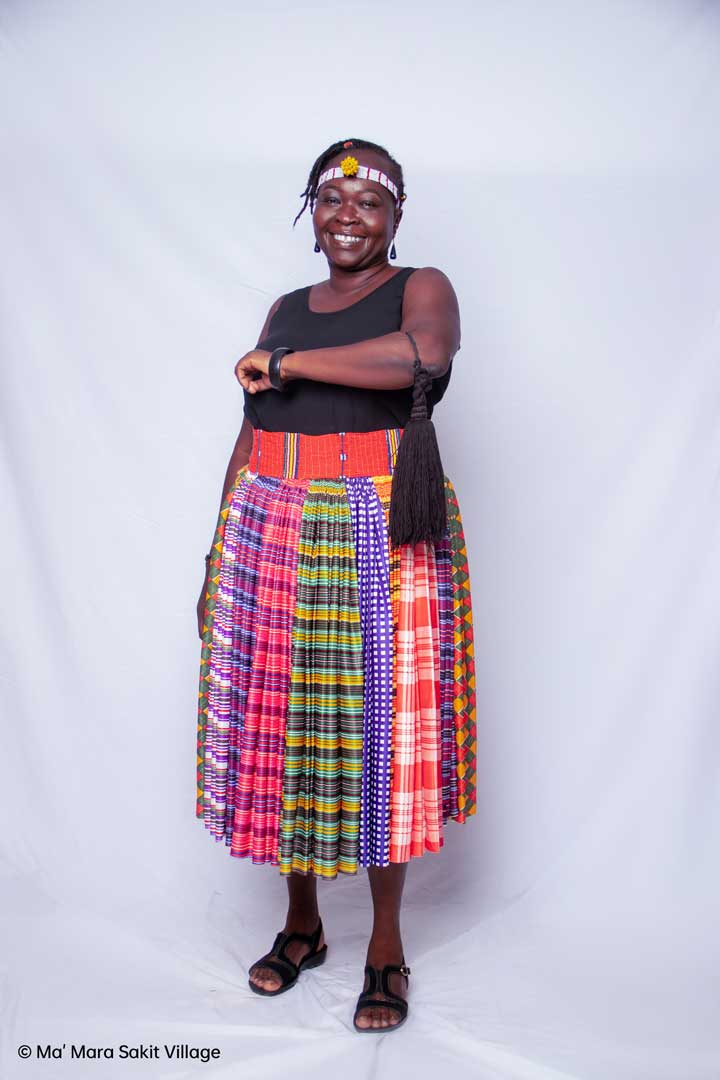
The Toposa attires are some of the most colorful and vibrant attires in South Sudan. While the main attire is the “Nyakilem,” the photo below is of secondary or optional clothing to the Toposa culture known as “Ngiboro.”
The Toposa attires are some of the most colorful and vibrant attires in South Sudan. While the main attire is the “Nyakilem,” the photo below is of secondary or optional clothing to the Toposa culture known as “Ngiboro.” The garment consists of a mixed-color skirt, “Nyetanurwa,” worn with beads on the waist known as “Nyachakakina,” and a touch of arm accessory referred to as “Nyelado.” The attire is mainly worn during marriage ceremonies, traditional occasions, or any celebrations/activities of joy. The beads on the head are known as “Nyatorokou.” The Toposa are known for the country’s most detailed and beautiful headpieces.
Source: Commissioner Epone Emmanuel
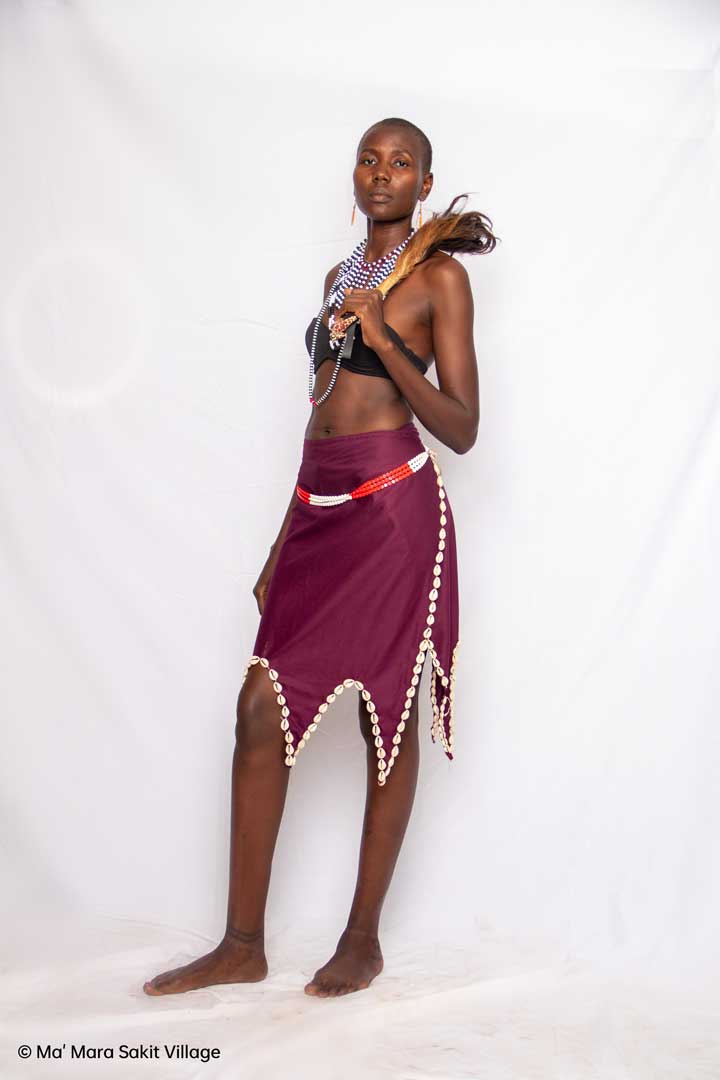
This attire consists of an open sides skirt known as “Biong” made of animal skin. The skirt is worn with “Gang” beads, a 6 line of tablet-like beads of the white & red color mixture around the waist & with either a black or white bra on top.
This attire consists of an open sides skirt known as “Biong” made of animal skin. The skirt is worn with “Gang” beads, a 6 line of tablet-like beads of the white & red color mixture around the waist & with either a black or white bra on top. This attire is beautifully adorned with a bundle (7 pieces) of plastic bangles on the ankles, in addition to a pair of 5 black jingles known as “Matiin” and a pair of 5 gold metal bangles on the ankles known as “Malang.”
Source: Ajing, Ajay Ayuel, with support from Acuil

This is a “Roko Bagadi” Azande attire, beautifully adorned with shell beads around the neck known as Amangburu or Azege. The knitted basket carried in the hands is the Kiaga.
This is a “Roko Bagadi” Azande attire, beautifully adorned with shell beads around the neck known as Amangburu or Azege. The knitted basket carried in the hands is the Kiaga.
This unique attire is typically worn by young unmarried women and maidens at the king’s palace during traditional functions to beautify the place where the king sits. It can be made in different colors depending on the ceremony. This color is for conventional ceremonies (i.e., marriages, birthdays, thanksgiving). The attire has a royal connection from back in the day when the garment was formal traditional wear for many Africans.
Source: Hon. Daniel Badagbu

This attire is known as Mejim (Biong), the leading and most attractive Bulpuny/Bulcengreel attire used on executive occasions by young women.
This attire is known as Mejim (Biong), the leading and most attractive Bulpuny/Bulcengreel attire used on executive occasions by young women. T-shirts or vests were recently adopted and incorporated. In the early days, Mejim was made of animal skin and smeared with a red substance known as paal in thuokreel. They were then decorated with Alual (big round beads around the waist to hold and support the mejim and its beautification. Juel (dhuor) is worn on the elbow, and above the elbow is Agheer (Tung Akoon), made of Ivory for decoration.
Sources: Reel women group with support from Amer Nhial and Majokdit with support from Mabor Deng.

For this curation, we couldn’t resist talking about one of South Sudanese women’s most delicate embroidery artwork; the famous hand-made embroidered lawa.
For this curation, we couldn’t resist talking about one of South Sudanese women’s most delicate embroidery artwork; the famous hand-made embroidered lawa. Adopted from the Shilluk (Collo) people, this lawa, worn mainly by men, is one of the most unifying cultural attires in South Sudan. It is used across different ethnic groups for weddings and other important cultural, community, national and international events/ceremonies. It is currently used nationally as a South Sudanese unique souvenir or gift to honor important guests, especially men, at events.
This embroidered lawa is a modernized version of the male lawa. Culturally, men across different ethnic groups wear lawa based on age group or status and are tied on the left, unlike the women’s lawa, which is tied on the right shoulder. Different ethnic groups use other materials, and the kinds of beads worn by men or boys with the lawa are also different from those worn by women and girls. For example, among the Collo, each village wears different colors, and the colors are further subdivided based on age or status.
By Aluel Atem
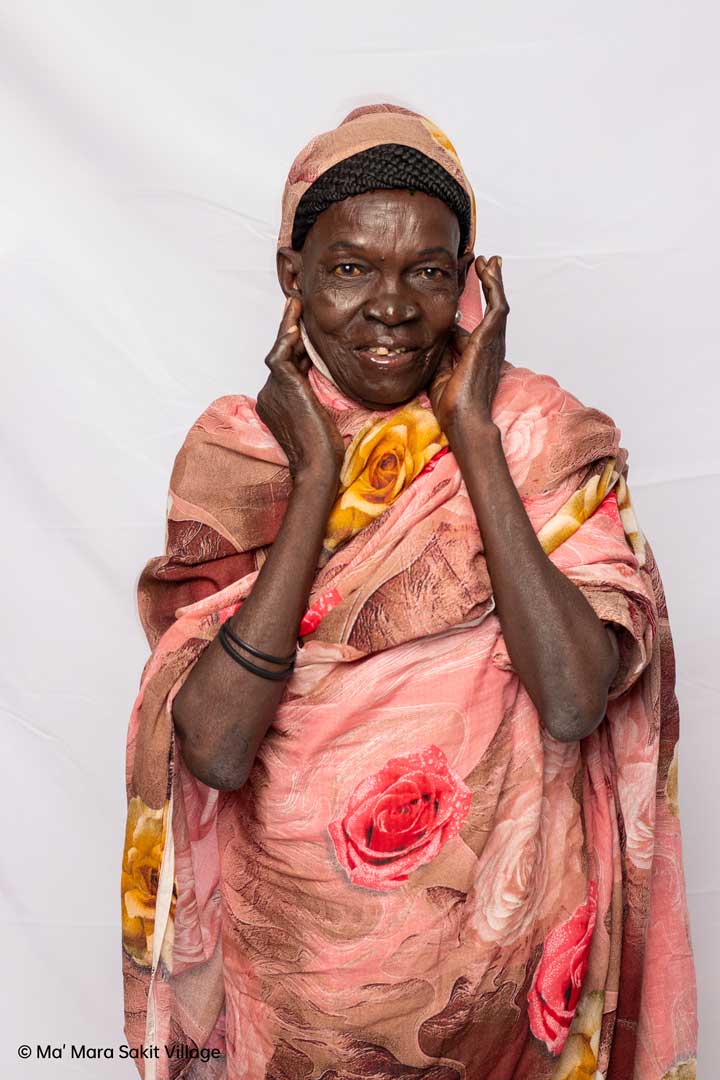
Thoub is a traditional Sudanese women's attire essential to any Sudanese woman’s wardrobe. Before separation, the two previously united Sudans shared many cultures and traditions and adopted each other's foods, accessories, and attires.
Thoub is a traditional Sudanese women's attire essential to any Sudanese woman’s wardrobe. Before separation, the two previously united Sudans shared many cultures and traditions and adopted each other's foods, accessories, and attires. The Thoub for women and “Jalabiya” for both men and women are the most popular adopted attires from the Sudanese culture into the South Sudanese.
Thoub is a cloth wrapped around the body in a fashionable (and often modest) manner. It is over 10,000 years old and was historically known as the national attire of queens. The Thoub was traditionally used to cover women due to the heavy influences of Islamist culture in Sudan in recent decades. It can be worn on any occasion as much as none. White thoubs are traditionally worn by professional women, elderly women, and widows; red thoubs are usually worn by brides in ‘jirtik’ wedding celebrations, while plain/multi-colored/floral thoubs are worn for both casual and non-casual events and ceremonies. In recent years, thoubs have become a staple of chic and artistic fashion and a canvas for a woman’s personality, with a wide assortment of fabrics including satin, silk, cotton, polyester, and others.
The attire in South Sudan is also quite popular during “Henna” party celebrations, a ceremony hosted before a wedding where the bride and groom are decorated with temporary Arab tattoos.
Thoub is arguably essential in the South Sudanese woman’s wardrobe as well.
Source: Co-written by Deema Waleed

Back in the day, girls wore a collection of beads on the head and neck without any vest or bra. Under, they wore a tiny cloth covering just the private parts called “Ajugo” or “Abonga.” Girls stayed naked, wearing beads with their breasts and abonga covering their private parts.
Back in the day, girls wore a collection of beads on the head and neck without any vest or bra. Under, they wore a tiny cloth covering just the private parts called “Ajugo” or “Abonga.” Girls stayed naked, wearing beads with their breasts and abonga covering their private parts. It was normal, and there were no sexual harassment or abuse cases. Today, girls wear bras or vests on top and skirts under with the collection of these beads. On the neck, three different types and sizes of beads are worn, not just one like in this photo. There is usually a much tighter one around the neck like a choker, followed by two slightly longer ones. The smallest bead falling to the forehead from her hair is called ‘Manydal,’ and only girls wear it. However, the bead tied around the waist is worn by both girls and women.
Source: Tereza Modesto

Beads and lawa (the long cloth tied around) are essential in the Naath community and are worn for important occasions such as weddings, initiations, and other significant community ceremonies.
Beads and lawa (the long cloth tied around) are essential in the Naath community and are worn for important occasions such as weddings, initiations, and other significant community ceremonies. The beads are worn in a way that is similar way like the Shilluk community. One is tried on the head, the other is put around the neck with a long tail on the back, while the lawa is usually tied on the left-hand side.
There is a slight difference between the lawa worn by women and girls. The ones for girls are lighter than the ones worn by women. Different communities wear different colors accordingly. For example, green is mostly worn by Leer County, yellow for Mayendit county, and white and black for Lou Nuer, famously known in Naath as “bor char.”
The color of the beads often matches the lawa of each community or county. During weddings, the bride is given beads and lawa color of her in-laws as a sign of welcoming her to the family. And from that day forth, she transitions to wearing the beads and lawa colors of her marital community or county.
Sources: Aunty ~Annie Zacharia with support from Nyalony Gatwang
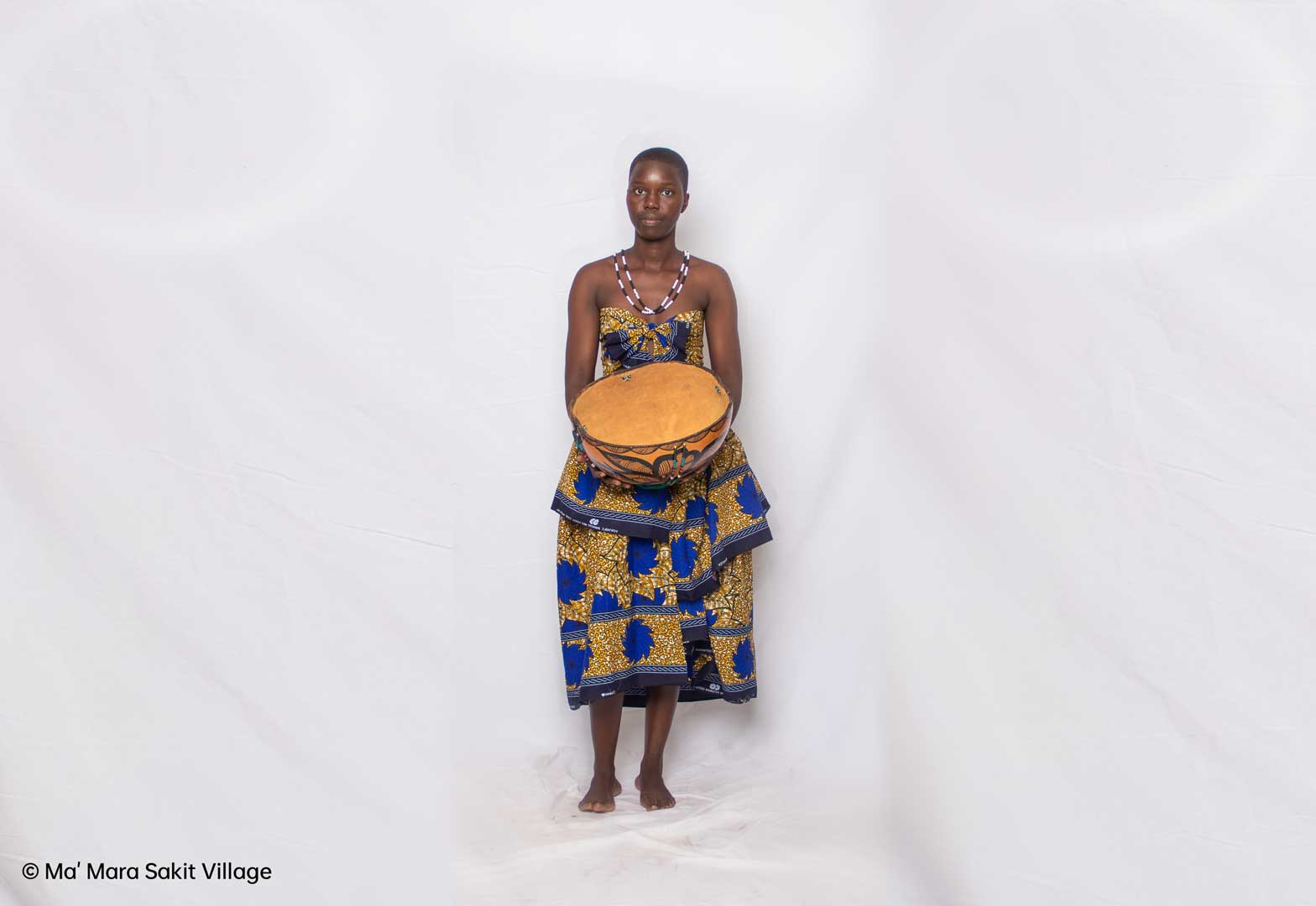
This is a modernized Acholi attire named “Maarina,” mostly worn during dance performances by both girls and women. Back in the day, before clothing was introduced, the Acholi wore leaves and animal skin.
This is a modernized Acholi attire named “Maarina,” mostly worn during dance performances by both girls and women.
Back in the day, before clothing was introduced, the Acholi wore leaves and animal skin. Cyeno (pronounced Chi-ye-no) for women and Layam’okwe for men. After the introduction of clothing, the Acholi created Tonduras (skirt) named Aleesann in Acholi and tied pieces on the chest. Unmarried girls wore short Tonduras with a white t-shirt while married women wore “Gomasi” or long Tonduras with a white t-shirt.
In the olden days, women wore Teela (black and white beads) on the neck and a bundle of tiny white beads on the waist. The bigger the piles, the better. Not to mention the beautiful brass bracelets named Ongul (pronounced Oh-nguul) for both men and women.
The Acholi people use two types of beads: big and small. The primary colors used are white, yellow, and green, every color except red. White represents peace, and the green represents vegetation. The beads are called Tiko.
As one of our most popular dance communities, the Acholi dance wears are specific to the type of dance. The most popular is the Marina. In a Royal dance titled Bwola dance, men would wear leopard skin (Pyen Kwac) and Colobus monkey skin (Pyen Dohlo) while holding drums and drumsticks accompanied by headgear made of Ostrich features called Kondoh and feet bells (Gaara) which both men and women wear during the dance.
Other popular Acholi dance types include Dingi-Dingi, in which girls only perform include wearing the Maarina, beads on the waist and necks, and Gaara on their feet, while Apitti dance; an only elderly women dancer include dressing in either the Maarina or Gigoyi, Gaara on the feet, as well as beads. Both men and women are accessorized by the Laruuk (small axes) during the performance.
Sources: Irene Krys, Mama Vivian Isidoro, and Mama Judith Kasara

GenderTalk211 is an African feminist traditional and multimedia platform that facilitates wholesome conversations on gender and sexuality.
© 2022. GenderTalk211, South Sudan. All Rights Reserved.
| Cookie | Duration | Description |
|---|---|---|
| cookielawinfo-checkbox-analytics | 11 months | This cookie is set by GDPR Cookie Consent plugin. The cookie is used to store the user consent for the cookies in the category "Analytics". |
| cookielawinfo-checkbox-functional | 11 months | The cookie is set by GDPR cookie consent to record the user consent for the cookies in the category "Functional". |
| cookielawinfo-checkbox-necessary | 11 months | This cookie is set by GDPR Cookie Consent plugin. The cookies is used to store the user consent for the cookies in the category "Necessary". |
| cookielawinfo-checkbox-others | 11 months | This cookie is set by GDPR Cookie Consent plugin. The cookie is used to store the user consent for the cookies in the category "Other. |
| cookielawinfo-checkbox-performance | 11 months | This cookie is set by GDPR Cookie Consent plugin. The cookie is used to store the user consent for the cookies in the category "Performance". |
| viewed_cookie_policy | 11 months | The cookie is set by the GDPR Cookie Consent plugin and is used to store whether or not user has consented to the use of cookies. It does not store any personal data. |